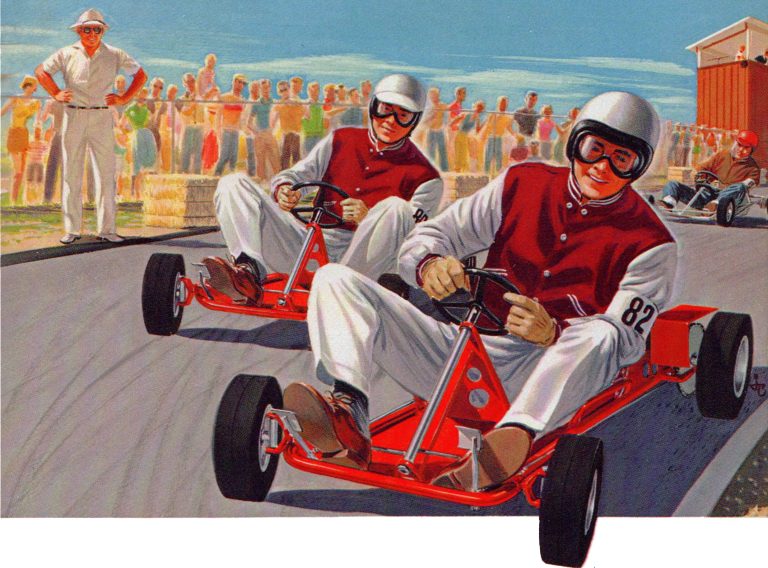Our tale begins in the mid-20th century, in Southern California, where a veteran hot rodder and race car builder named Art Ingels was about to make history. In 1956, using his expertise from Kurtis Kraft, a prominent builder of Indianapolis 500 race cars, Ingels crafted the very first kart. He combined a small, tube-frame structure with a two-cycle lawnmower engine, and voilà, kart racing was born.
Ingels didn’t keep his invention to himself; instead, he showcased it in a local parking lot, sparking the interest of his friends. Soon, impromptu kart races were taking place in the Rose Bowl parking lot. In just two swift years, in 1958, the first official kart racing track emerged in Azusa, California, solidifying karting’s place in the world of motorsports.
The Birth of the Go-Kart
Duffy Livingston, a muffler-shop owner in Los Angeles, contributed to the popularity of karting by coining the term “Go-Kart.” He went on to manufacture and sell these machines under the Go-Kart name, becoming the first kart manufacturer. While Art Ingels is credited with building the initial kart, Livingston is rightfully acknowledged for launching its popularity.
Two-Cycle Engines: Power in a Small Package
Kart engines have been predominantly two-cycle or “two-stroke” engines since the late 1950s. Despite their small size, these engines deliver impressive power. In 1959, a company known for its chainsaws, McCulloch, became the first to produce dedicated kart engines. Rival engine manufacturers, including Clinton, Power Products, and West Bend, soon joined the competition.
From Local Pastime to Global Phenomenon
Karting quickly gained popularity and publicity, thanks to motoring magazines like Hot Rod and Rod & Custom. Karts even made their way into popular culture, with appearances in movies starring celebrities like Steve McQueen and The Beatles. Karting became an instant sensation, with new kart tracks appearing on undeveloped squares of asphalt across the United States.
However, many considered karting a passing fad. Yet, it proved its staying power and evolved into a serious form of motorsport. In the United States, kart racing was initially managed by the Go Kart Club of America, later by the International Kart Federation, and the World Karting Association. Internationally, the CIK/FIA became the governing body overseeing karting competitions worldwide, including the prestigious World Karting Championships.
The Evolution of Kart Design
Early karts were simple and straightforward, featuring hand-activated mechanical brakes, direct-drive motors (no clutch), and hard industrial rubber tires. Suspensions were absent, replaced by lightning-quick direct steering that required an intimate connection with the road.





During the late 1950s and early 1960s, kart design saw some development, but not much. Live (solid) rear axles and left-pedal-operated hydraulic disc brakes became standard. Centrifugal clutches eliminated the need for push starts, and kart engines grew in power, many running on methanol with a few adding a splash of nitro. Wider and grippier tires improved performance.
Modern Karting at Niagara Speedway
Fast forward to today, and you’ll find a modern variant of karting at the Niagara Speedway go-kart track in Niagara Falls, Ontario. The Niagara Speedway track offers an exciting experience for both beginners and karting enthusiasts. The karts are equipped with the latest technology, providing an adrenaline-pumping ride on a multi-level, spiral track.
Whether you’re a fan of motorsports or just seeking a thrilling adventure, the Niagara Speedway go-kart track is the place to be. Experience the evolution of karting firsthand as you navigate the twists and turns of this state-of-the-art track.
Conclusion
Karting, once born out of curiosity and a love for speed, has grown into a global phenomenon. From its humble beginnings in a California parking lot to the modern racing experience offered at the Niagara Speedway, karting has come a long way. It continues to serve as the breeding ground for future racing champions, teaching essential skills that translate into success in top-tier motorsports.
So, next time you witness a Formula 1 champion tearing up the racetrack, remember that they likely honed their skills in these diminutive yet powerful machines. Karting is not just a sport; it’s a legacy, and it all started with a few friends racing around a parking lot in Glendale, California, more than six decades ago. The world of motorsports hasn’t been the same since.














